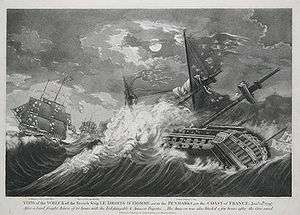French ship Droits de l'Homme (1794)
 Fight of the Droits de l'Homme, by Léopold Le Guen | |
| History | |
|---|---|
| Name: | Droits de l'Homme |
| Namesake: | La Déclaration des droits de l'Homme et du citoyen |
| Builder: | Port-Liberté (now Lorient) |
| Launched: | 10 Prairial de l'An II (29 May 1794) |
| Fate: | Beached, 13 January 1797 |
| General characteristics [1] | |
| Class and type: | Téméraire-class ship of the line |
| Displacement: |
|
| Length: | 55.87 metres (183.3 ft) (172 pied) |
| Beam: | 14.90 metres (48 ft 11 in) |
| Draught: | 7.26 metres (23.8 ft) (22 pied) |
| Propulsion: | Up to 2,485 m2 (26,750 sq ft) of sails |
| Armament: |
|
| Armour: | Timber |
Droits de l'Homme ("Rights of Man") was a Téméraire class 74-gun ship of the line of the French Navy during the French Revolution.
Ship history
The ship was built at Port-Liberté (now Lorient) and launched on 10 Prairial de l'An II (29 May 1794).[2]
Droits de l'Homme, was involved in the Action of 6 November 1794, chasing the British 74s Canada and Alexander. Droits de l'Homme caught up with Alexander first, but was forced out of action with damage to her rigging, but Alexander was soon caught by Jean Bart and Marat and captured.
Droits de l'Homme was lightly involved in Battle of Groix, on 22 June 1795, firing few if any shots during the battle.
In December 1796 Droits de l'Homme, under capitaine de vaisseau Raymond de Lacrosse, took part in the invasion attempt against Ireland, carrying 549 soldiers. On their way, the fleet was dispersed by tempests. The Droits de l'Homme arrived at Bantry Bay and cruised off the coast, capturing the brigs Cumberland and Calypso. She stayed there for eight days to ascertain that no French ship was in distress on the coast, and departed for Brittany.

On 25 Nivôse An V in the Action of 13 January 1797, off Penmarch, Droits de l'Homme met the British frigates HMS Indefatigable (44), under Sir Edward Pellew, and Amazon (36), commanded by Robert C. Reynolds. The sea was rough, preventing Droits de l'Homme from using her lower deck batteries and from boarding the British. Lacrosse was wounded; he gave command of the ship to his second officer, Prévost de Lacroix, and had his crew swear not to strike their colours.[3]
After 13 hours of combat, running out of ammunition, the British broke contact when Indefatigable sighted land ahead. Indefatigable, despite having damage to her masts and rigging, managed to beat off the lee shore and escape Penmarch reefs; Amazon ran aground and was destroyed near Plozévet, and her crew captured. Droits de l'Homme, having lost her rudder, masts and anchors, ran aground off Plozévet.[4]
Some of the crew were rescued by the ship's boats and fishing boats from nearby villages, but the rescue was interrupted for five days by the storm; 60 men died for lack of food and water. General Jean-Amable Humbert, who was commanding the soldiers aboard, narrowly escaped drowning, and between 250 and 390 men died in the wreck. Captain Lacrosse was last to leave the ship.
In 1840, Major Pipon, an English officer who had been a prisoner aboard, erected an inscribed menhir on the coast in remembrance of the tragedy. In 1876 it was broken into several pieces by the weather, but restored in 1882.[5]
References
- ↑ Clouet, Alain (2007). "La marine de Napoléon III : classe Téméraire - caractéristiques". dossiersmarine.free.fr (in French). Retrieved 4 April 2013.
- ↑ "Naufrage du Les Droits de l'Homme ("The Sinking of the Droits de l'Homme")". sourdaine.org (in French). 2011. Retrieved 1 April 2013.
- ↑ Parkinson, C. Northcote (1934) Edward Pellew, Viscount Exmouth, Admiral of the Red. London: Methuen & Co., pp. 175-78
- ↑ Parkinson, C. Northcote (1934) Edward Pellew, Viscount Exmouth, Admiral of the Red. London: Methuen & Co., pp. 179-80
- ↑ "Menhir du vaisseau Droits de l'homme, Plozévet". fr.topic-topos.com. 2013. Retrieved 1 April 2013.
External links
| Wikimedia Commons has media related to French ship Droits de l'Homme (1794). |
- Dennis A., Wheeler (1999). "The destruction of the French warship Droits de l'Homme, 14 January 1797: The climatic background to a famous event in English naval history" (PDF). Weather. Royal Meteorological Society. 54 (5): 135–141. doi:10.1002/j.1477-8696.1999.tb06444.x.
Coordinates: 47°57′37.19″N 4°25′42.42″W / 47.9603306°N 4.4284500°W